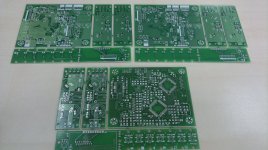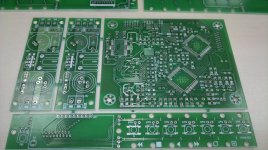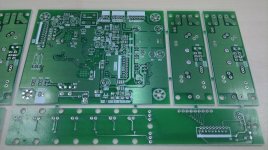Sorry for causing trouble
Tibi,
I didn't mean to stir the hornets nest with my suggestion. Naturally, a display is better if possible.
As for me, I'm not growing impatient at all. I really appreciate all the effort that you especially and others have put into this project. It seemed from the outside that things were getting difficult in the area of the display. I didn't have any knowledge that would help you find a solution, so tried thinking out of the box. Sorry for causing trouble.
Overall, we are all with you and will support you in any way we can.
Tibi,
I didn't mean to stir the hornets nest with my suggestion. Naturally, a display is better if possible.
As for me, I'm not growing impatient at all. I really appreciate all the effort that you especially and others have put into this project. It seemed from the outside that things were getting difficult in the area of the display. I didn't have any knowledge that would help you find a solution, so tried thinking out of the box. Sorry for causing trouble.
Overall, we are all with you and will support you in any way we can.
In understand that some of you may lost their patience, but display is a must for any CD player/transport.
The display board will have two options:
1. direct drive to LCD
2. drive to LED matrix trough atmel
Regards,
Tibi
Don't forget an off switch(on remote if possible,and if not add some$) for display, my Meridian 602 is on 24/7/365 for years and my display is off at 99.99%
Last edited:
Don't forget an off switch(on remote if possible,and if not add some$) for display, my Meridian 602 is on 24/7/365 for years and my display is off at 99.99%
+1
Don't forget an off switch(on remote if possible,and if not add some$) for display, my Meridian 602 is on 24/7/365 for years and my display is off at 99.99%
The display is a multiplexed LCD and can not be switched off unless you power off the DSP.
Anyhow, we have ordered an transmissive LCD with back-light and switching off the back-light will give you the effect needed.
Regards,
Tibi
Hi Fran,
Just to feedback... Thank you very much sharing the Precision Attenuators approach.. I tried it ... yes much better than using resistors alone.. as you can easily dial in and optimise the sound... I ended up with a total of 30db attenuation..
Just to feedback... Thank you very much sharing the Precision Attenuators approach.. I tried it ... yes much better than using resistors alone.. as you can easily dial in and optimise the sound... I ended up with a total of 30db attenuation..
Right now I'm using a 20dB at one end of the cable and a 15dB at the other end. I did try them directly in series but I couldn't tell any difference. I'm using a buffalo dac (one of the earlier ones) and it stays locked no problem at that level. I think if I were ordering them up I would order a few - maybe get a 2 x 15db, 10 and a 6 as well. That would give you many combinations. That 25+15 was the highest amount I could go without causing dropout on the spdif line, so if your dac needs a slightly higher signal to lock on, then it might not work with that much attenuation.
Fran
Those look nice. Any word on what the price is going to be for those of us signed up for them? I'm looking forward to putting this one together for sure.
These are prototype boards and cost us a lot.
When the boards are populated and the project tested, we are going to negotiate final order with PCB factory. Till then I can not give any price.
Regards,
Tibi
Hi Fran,
Just to feedback... Thank you very much sharing the Precision Attenuators approach.. I tried it ... yes much better than using resistors alone.. as you can easily dial in and optimise the sound... I ended up with a total of 30db attenuation..
BTW - sorry for not being back here sooner. That's exactly what I heard - and I think the 2 of us are the only people to have tried it out here. Well done!!
tvicol: well done on the boards! when you build one, have you got an original shiga to compare?
Fran
BTW - sorry for not being back here sooner. That's exactly what I heard - and I think the 2 of us are the only people to have tried it out here. Well done!!
tvicol: well done on the boards! when you build one, have you got an original shiga to compare?
Fran
I have tried your attenuator too now. I have not finished my tests yet, but I am already convinced that it is better than all the commercial resistor combinations I have tried thus far. The degree of the difference surprised me too - ordinarily, one would have to strain and focus to be able to tell, say an Audio Note's Tantalum from a Kiwame: both rather grainy, and only separated by Kiwame's slight warmth. In the case of the attenuator, the difference is plainly obvious - an across-the-board improvement. Especially, the wide soundstage, great dynamics and instrument separation is very noticeable.
However, the most important comparison (to me at least) I put off till the end - will my own hand-made resistors emerge victorious again?
At any rate - great find Fran, this attenuator is indeed excellent!
I have tried your attenuator too now. I have not finished my tests yet, but I am already convinced that it is better than all the commercial resistor combinations I have tried thus far. The degree of the difference surprised me too - ordinarily, one would have to strain and focus to be able to tell, say an Audio Note's Tantalum from a Kiwame: both rather grainy, and only separated by Kiwame's slight warmth. In the case of the attenuator, the difference is plainly obvious - an across-the-board improvement. Especially, the wide soundstage, great dynamics and instrument separation is very noticeable.
However, the most important comparison (to me at least) I put off till the end - will my own hand-made resistors emerge victorious again?I have my initial impressions already, and I feel I know the answer, but I need to do further listening to make sure I'm not being biased.
At any rate - great find Fran, this attenuator is indeed excellent!
Fran, BTW, uncle_leon,
I would appreciate you guide me towards posts or thread, to read more about what you three have done with the attenuators.
...
tvicol: well done on the boards! when you build one, have you got an original shiga to compare?
Fran
Yes, we have an original shiga for final comparison.
Regards,
Tibi
- Home
- Source & Line
- Digital Source
- Finally, an affordable CD Transport: the Shigaclone story


